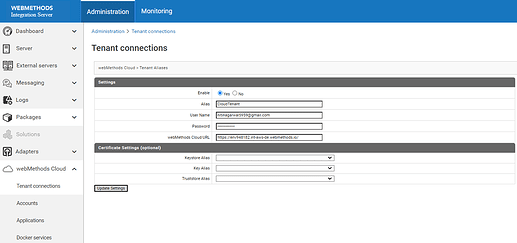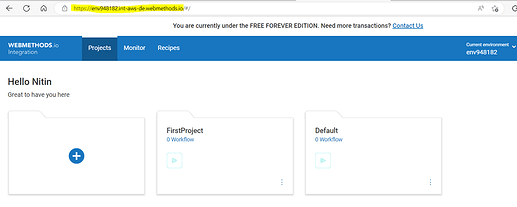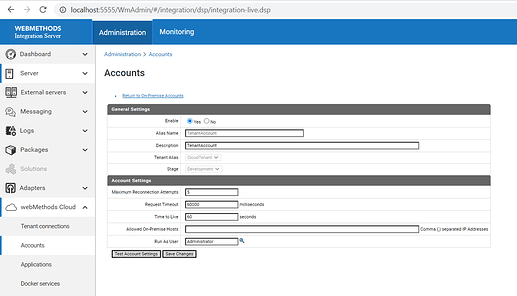Introduction
Hybrid Integration allows access from webMethods.io Integration cloud environment to webMethods on premise Integration Server.
In this Article we will walk through -
1)How to setup connectivity between webMethods.io cloud environment to webMethods on premise integration server.
2)Create a flow service within on promise webMethods integration server and upload the flow service as an application to webMethods.io Cloud environment.
3)Creating a workflow in webMethods.io integration environment and invoke the uploaded application as a connector.
Pre-requisite
To configure Hybrid Integration; Please verify “ WmCloud ” package is installed and enabled in the on premise Integration Server.
Steps to follow
Step 1: Setting up connectivity from webMethods.io cloud environment to webMethods on premise Integration server:
a) Firstly we have to open on premise integration server and navigate to webMethods Cloud → Tenant connections → create tenant connections to create tenant connection for the cloud environment.
Provide the details like Alias (any name), username, password , webMethods Cloud URL for the respective webMethods.io cloud environment and then click on update setting.
Note : webMethods Cloud URL can be copied from your cloud environment web UI like below:
As soon as we click on update setting you will see success message which means connection from on premise to cloud environment is established.
b) The next step is to create on premise account. For that navigate to webMethods Cloud → Accounts tab in your on premise integration server and then click on Create on premise account.
Provide the details like Alias Name (you can provide any name) , Description, Tenant Alias (same as created in previous step), Stage. Account settings can be kept default, provide Run as User Administrator and click on Save changes.
Account Settings:
Maximum Reconnection Attempts : Specify the maximum number of reconnections attempts that Integration Server should make if the connection to Integration Cloud fails.
Request Timeout : Maximum amount of time (in milliseconds) that Integration Cloud waits for the on-premise Integration Server to process a request.
Time to Live : If you are batching the data from the on-premise Integration Server, the length of time in seconds that the execution results remain in the cache of the on-premise Integration Server. The value must be greater than 0. The default is 60 seconds.
Allowed On-Premise Hosts : (Optional.) The on-premise Integration Server might use multiple addresses, depending on which network or proxy it uses to access Integration Cloud. Specify a comma-separated list of IP addresses that can receive requests from Integration Cloud. Only those IP addresses specified can receive requests.
Run As User : The user name you want the on-premise Integration Server to use when running the service. You can select users from the local or central directory.
After that you can test the account by clicking on Test icon and a message should appear like the account is valid as below:
c) The next step is we need to upload the on premise account to webMethods.io cloud environment. For this click on Upload under Accounts tab and click ok.
On clicking Ok the account will be uploaded to webMethods.io cloud environment:
To get the full, detailed guide on how to create a flow service within an on promise webMethods integration server and upload the flow service as an application to webMethods.io Cloud environment and creating a workflow in webMethods.io integration environment and invoking the uploaded application as a connector, please visit the Software AG Tech Community Forum with the following link:











Top comments (0)